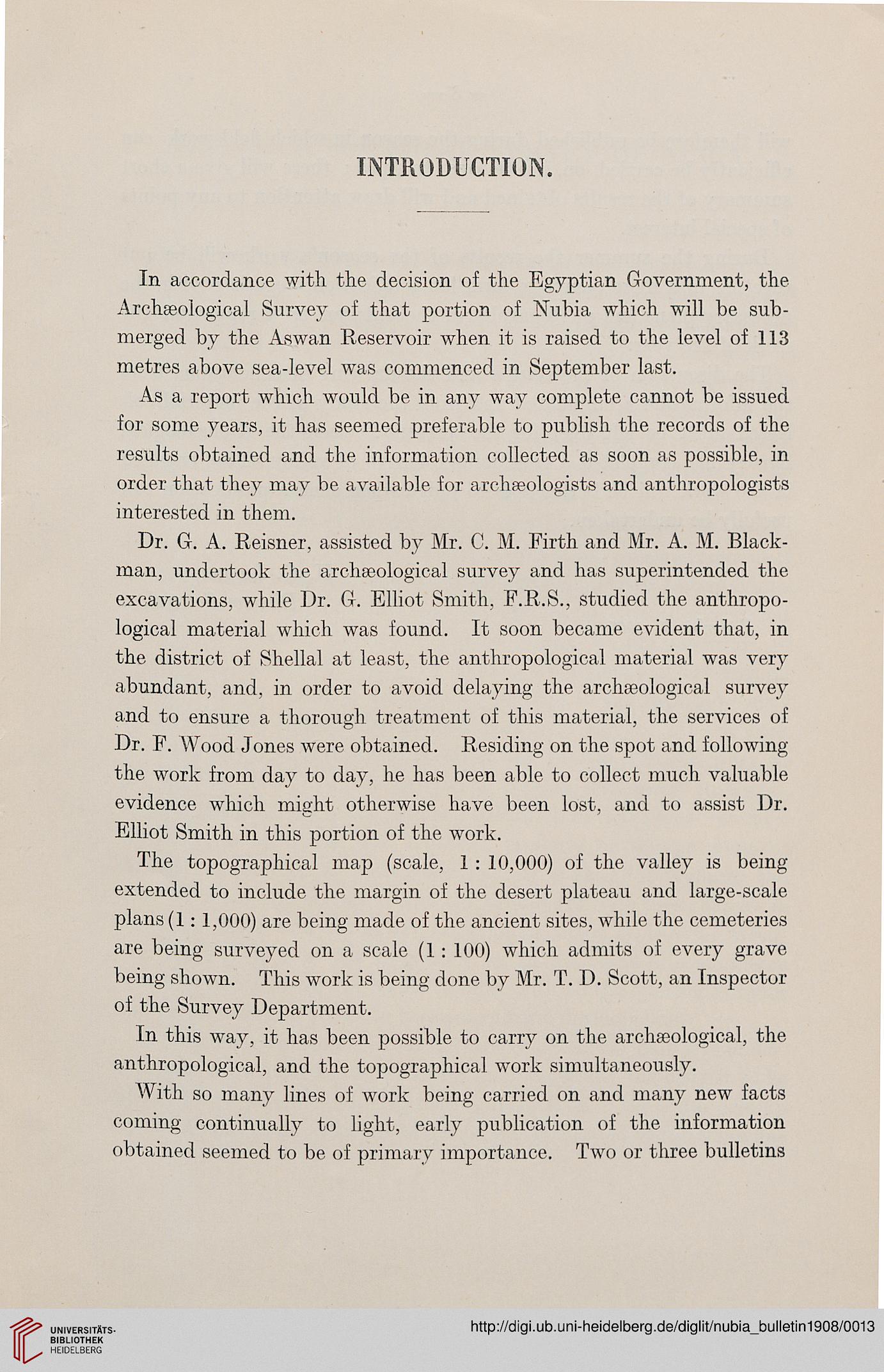INTRODUCTION.
In accordance with the decision of the Egyptian Government, the
Archaeological Survey of that portion of Nubia which will be sub-
merged by the Aswan Reservoir when it is raised to the level of 113
metres above sea-level was commenced in September last.
As a report which would be in any way complete cannot be issued
for some years, it has seemed preferable to publish the records of the
results obtained and the information collected as soon as possible, in
order that they may be available for archaeologists and anthropologists
interested in them.
Dr. G. A. Eeisner, assisted by Mr. C. M. Firth and Mr. A. M. Black-
man, undertook the archaeological survey and has superintended the
excavations, while Dr. Gr. Elliot Smith, F.R.S., studied the anthropo-
logical material which was found. It soon became evident that, in
the district of Shellal at least, the anthropological material was very
abundant, and, in order to avoid delaying the archaeological survey
and to ensure a thorough treatment of this material, the services of
Dr. F. Wood Jones were obtained. Residing on the spot and following
the work from day to day, he has been able to collect much valuable
evidence which might otherwise have been lost, and to assist Dr.
Elliot Smith in this portion of the work.
The topographical map (scale, 1 : 10,000) of the valley is being
extended to include the margin of the desert plateau and large-scale
plans (1: 1,000) are being made of the ancient sites, while the cemeteries
are being surveyed on a scale (1: 100) which admits of every grave
being shown. This work is being done by Mr. T. D. Scott, an Inspector
of the Survey Department.
In this way, it has been possible to carry on the archaeological, the
anthropological, and the topographical work simultaneously.
With so many lines of work being carried on and many new facts
coming continually to light, early publication of the information
obtained seemed to be of primary importance. Two or three bulletins
In accordance with the decision of the Egyptian Government, the
Archaeological Survey of that portion of Nubia which will be sub-
merged by the Aswan Reservoir when it is raised to the level of 113
metres above sea-level was commenced in September last.
As a report which would be in any way complete cannot be issued
for some years, it has seemed preferable to publish the records of the
results obtained and the information collected as soon as possible, in
order that they may be available for archaeologists and anthropologists
interested in them.
Dr. G. A. Eeisner, assisted by Mr. C. M. Firth and Mr. A. M. Black-
man, undertook the archaeological survey and has superintended the
excavations, while Dr. Gr. Elliot Smith, F.R.S., studied the anthropo-
logical material which was found. It soon became evident that, in
the district of Shellal at least, the anthropological material was very
abundant, and, in order to avoid delaying the archaeological survey
and to ensure a thorough treatment of this material, the services of
Dr. F. Wood Jones were obtained. Residing on the spot and following
the work from day to day, he has been able to collect much valuable
evidence which might otherwise have been lost, and to assist Dr.
Elliot Smith in this portion of the work.
The topographical map (scale, 1 : 10,000) of the valley is being
extended to include the margin of the desert plateau and large-scale
plans (1: 1,000) are being made of the ancient sites, while the cemeteries
are being surveyed on a scale (1: 100) which admits of every grave
being shown. This work is being done by Mr. T. D. Scott, an Inspector
of the Survey Department.
In this way, it has been possible to carry on the archaeological, the
anthropological, and the topographical work simultaneously.
With so many lines of work being carried on and many new facts
coming continually to light, early publication of the information
obtained seemed to be of primary importance. Two or three bulletins





